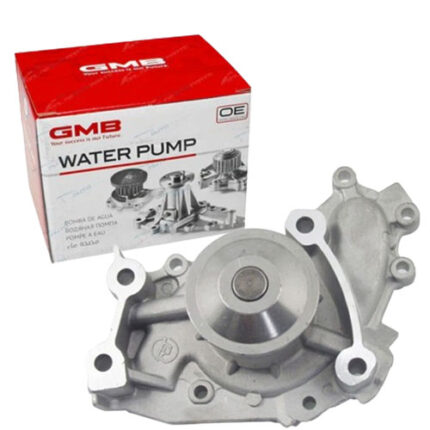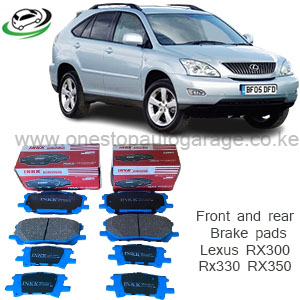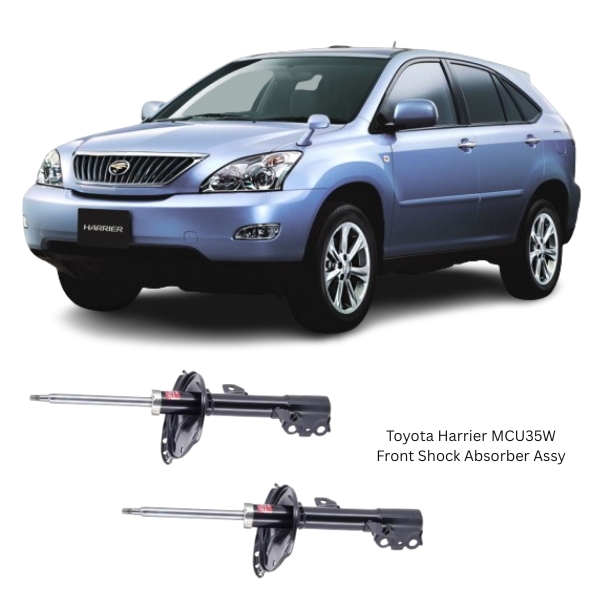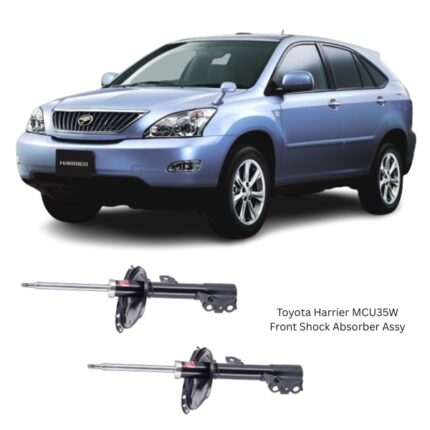Get Toyota Harrier MCU35W Front Shock Absorber Assy 334400 / 334399 in Kenya
The Front Shock Absorber Assembly is a crucial component of the vehicle’s suspension system, playing an essential role in controlling ride quality, handling, and overall driving safety. It is designed to dampen the vibrations and impacts that occur when a vehicle travels over uneven surfaces, potholes, or during rapid changes in direction or speed.
Positioned at the front axle, the front shock absorber assembly connects the vehicle’s suspension system to the frame or body, absorbing energy from road irregularities and ensuring the tires remain in firm contact with the road. This continuous regulation of motion enhances comfort, driving stability, and braking performance.
Function and Purpose
The primary function of the front shock absorber assembly is to absorb and dissipate kinetic energy from the suspension movement. As the vehicle encounters bumps, dips, or cornering forces, the suspension springs compress and expand. Without shock absorbers, these motions would continue uncontrollably, making the vehicle unstable and uncomfortable.
The shock absorber assembly performs the following key functions:
-
Controls Spring Oscillations: Prevents excessive bouncing after passing over a bump or hole.
-
Maintains Tire Contact: Ensures consistent contact between the tires and the road for maximum grip and control.
-
Enhances Ride Comfort: Minimizes vibrations and jolts experienced by passengers.
-
Improves Braking Stability: Prevents nose-diving during braking and reduces stopping distances.
-
Reduces Body Roll: Limits excessive tilting or swaying during cornering or maneuvering.
-
Supports Load Handling: Helps the vehicle maintain its intended height and balance under varying load conditions.
Components and Structure
The front shock absorber assembly is typically composed of the following parts, each serving a specific mechanical function:
1. Shock Absorber (Damper)
This is the core component responsible for damping the movement of the suspension. It usually contains a piston that moves through hydraulic oil or gas within a sealed tube. The resistance to this movement is what absorbs and dissipates energy.
-
Twin-Tube Design: Features an inner and outer tube for fluid transfer, commonly used for standard driving conditions.
-
Mono-Tube Design: A single tube construction with a floating piston, offering better heat dissipation and performance for high-demand driving.
2. Coil Spring (Strut Assembly Only)
In integrated designs like strut assemblies, the coil spring surrounds the damper and supports the vehicle’s weight while also helping to absorb larger road impacts.
3. Mounting Plate or Bearing
Located at the top of the shock, this component attaches the assembly to the vehicle’s chassis or frame. It may include a bearing to facilitate steering movement and reduce friction.
4. Dust Boot and Bump Stop
-
Dust Boot: Protects the piston rod from dirt, moisture, and road debris.
-
Bump Stop: Prevents metal-to-metal contact and damage when the suspension bottoms out.
5. Lower Mount/Bracket
Attaches the bottom end of the shock absorber to the steering knuckle or control arm.
Together, these components ensure proper energy absorption, smooth motion transfer, and structural support to the front end of the vehicle.
How It Works
When the front wheels encounter a bump, the wheel moves upward, compressing the suspension spring. As the spring recoils, the shock absorber resists this movement using hydraulic or gas pressure inside its cylinder. The internal piston moves through the fluid, converting kinetic energy into heat, which is then dissipated through the shock body.
This process happens instantly and repeatedly, smoothing out the ride and maintaining control. High-performance shocks may feature adjustable valves or gas-charging for faster response and firmer handling.
Signs of Wear and Replacement Needs
Front shock absorbers endure high loads and constant movement. Over time, they wear out due to fluid leaks, seal failure, or internal component fatigue. Common signs of worn or failing front shock absorber assemblies include:
-
Excessive Bouncing: The front end continues to bounce after hitting a bump.
-
Nose-Diving During Braking: The front dips excessively when brakes are applied.
-
Uneven Tire Wear: Indicates poor contact and damping effectiveness.
-
Fluid Leakage: Visible oil on the shock body or surrounding components.
-
Poor Handling: Reduced cornering stability and increased body roll.
-
Unusual Noises: Clunking, knocking, or rattling when driving over rough surfaces.
Timely inspection and replacement are crucial to maintaining safe vehicle operation and ride comfort.
Installation Considerations
Replacing a front shock absorber assembly involves:
-
Lifting the Vehicle: Securely elevating the front end to relieve load on the suspension.
-
Removing Wheels: Providing access to the suspension components.
-
Detaching the Old Assembly: Unbolting the top and bottom mounts and removing the shock from the vehicle.
-
Installing the New Assembly: Ensuring proper alignment and torque on all fasteners.
-
Checking Alignment: Post-installation alignment ensures the new shocks perform correctly and do not affect steering geometry.
Professional installation is recommended, as proper torque specifications, alignment angles, and spring compression tools are critical to safety and performance.
Benefits of a New Front Shock Absorber Assembly
Upgrading or replacing your front shock absorber assembly offers immediate and long-term benefits, including:
-
Restored Ride Comfort: Elimination of vibrations and harshness from road imperfections.
-
Enhanced Handling and Control: Tighter steering response and better road feedback.
-
Improved Braking Efficiency: Shorter stopping distances and improved balance.
-
Even Tire Wear: Helps maintain proper tire contact and prolongs tire life.
-
Reduced Wear on Suspension Components: Absorbing impacts reduces stress on joints, bushings, and bearings.
-
Increased Safety: Overall improvement in driver confidence and vehicle control.
Lifespan and Maintenance
The typical lifespan of front shock absorbers ranges between 50,000 to 90,000 kilometers, depending on driving habits, road conditions, and load frequency. While not traditionally serviced, shocks should be inspected every 20,000 kilometers for leaks, wear, or mounting issues.
Maintaining proper wheel alignment, tire pressure, and avoiding overloading can help extend the life of the shock absorber assembly. Timely replacement ensures that other suspension components do not wear prematurely due to inadequate damping.
Follow us on Facebook for more parts.




